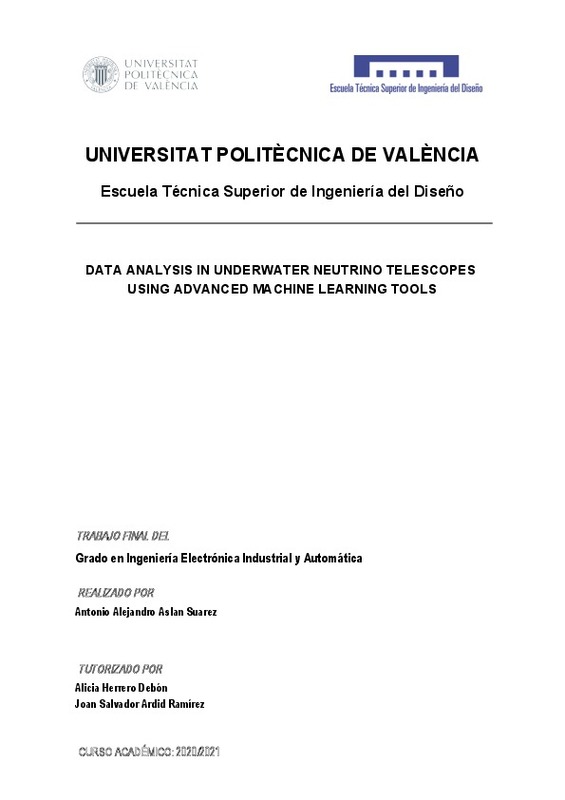|
Resumen:
|
[ES] Las radiaciones electromagnéticas no son la única forma que el ser humano tiene para estudiar los astros, de hecho, el estudio de la trayectoria de los neutrinos que llegan a la Tierra puede permitir el estudio de ...[+]
[ES] Las radiaciones electromagnéticas no son la única forma que el ser humano tiene para estudiar los astros, de hecho, el estudio de la trayectoria de los neutrinos que llegan a la Tierra puede permitir el estudio de objetos celestes masivos y energéticos a distancias mucho mayores de lo que el espectro electromagnético podría permitir. Sin embargo, estas partículas subatómicas solo pueden ser estudiadas indirectamente utilizando la luz de Cherenkov captada por las líneas de fotorreceptores que forman los telescopios de neutrinos como el Telescopio ANTARES. Actualmente, los datos obtenidos por el telescopio ANTARES son analizados mediante dos algoritmos que son capaces de estimar las componentes de la trayectoria de los neutrinos. El problema de estos algoritmos reside en que requieren que el evento sea captado por múltiples líneas para obtener un buen resultado, pero la mayoría de eventos captados por el telescopio son registrados por una única línea, por tanto, hay muchos eventos de los cuales no se puede extraer toda la información útil. Teniendo en cuenta el vacío existente en la capacidad actual de estimación de trayectorias de estos eventos, el objetivo de este trabajo es la creación de un algoritmo capaz de mejorar las capacidades de predicción de los algoritmos existentes para la estimación de la componente Zenit de la trayectoria de los eventos captados en el telescopio ANTARES por una única línea. Además, el modelo resultante también será utilizado para realizar una primera estimación de la energía del neutrino.
Por otro lado, y a diferencia con los algoritmos utilizados actualmente, en nuestro caso optaremos por utilizar un modelo de red neuronal, ya que, al ser un algoritmo de aprendizaje automático multipropósito, estos modelos son capaces de identificar y realizar la regresión de cualquier tipo de función no lineal. Concretamente, el modelo final obtenido es una red neuronal convolucional capaz de obtener una distribución probabilística de la componente Zenit de la trayectoria del neutrino en base a imágenes realizadas con la información recibida en los fotorreceptores. La capacidad del algoritmo dearrollado ha logrado disminuir el error de estimación de la trayectoria en un 50% comparado con los algoritmos actuales, demostrando así que utilizar un modelo de aprendizaje automático puede suponer una mejor opción para realizar la estimación de trayectorias.
[-]
[EN] The electromagnetic spectrum is not the only way for humans to study the stars; in fact, the study of the trajectory of neutrinos arriving at Earth can allow the study of massive and energetic celestial objects at ...[+]
[EN] The electromagnetic spectrum is not the only way for humans to study the stars; in fact, the study of the trajectory of neutrinos arriving at Earth can allow the study of massive and energetic celestial objects at distances much greater than the electromagnetic spectrum would allow. However, these subatomic particles can only be studied indirectly using the Cherenkov light captured by the photoreceptor lines that form neutrino telescopes such as the ANTARES Telescope. Currently, the data obtained by the ANTARES telescope is analyzed by two algorithms that are able to estimate the neutrino trajectory components. The problem with these algorithms is that they require the event to be captured by multiple lines to obtain a good result, but most of the events captured by the telescope are recorded by a single line, so there are many events from which not all the useful information can be extracted. Taking into account the existing gap in the current capability of estimating trajectories of these events, the objective of this work is to create an algorithm capable of improving the prediction capabilities of existing algorithms for the estimation of the Zenith component of the trajectory of events captured at the ANTARES telescope by a single line. In addition, the resulting model will also be used to make a first estimate of the neutrino energy.
On the other hand, and unlike the algorithms currently used, in our case we will choose to use a neural network model, since, being a multipurpose machine learning algorithm, these models are capable of identifying and performing the regression of any type of nonlinear function. Specifically, the final model obtained is a convolutional neural network capable of obtaining a probabilistic distribution of the Zenit component of the neutrino trajectory based on images made with the information received in the photoreceptors. The capacity of the developed algorithm has managed to reduce the trajectory estimation error by 50% compared to current algorithms, thus demonstrating that using a machine learning model can be a better option for trajectory estimation.
[-]
|







